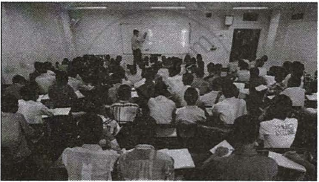Advertisements
Advertisements
Question
Find the value of k for which the following system of equations has a unique solution:
4x - 5y = k
2x - 3y = 12
Solution
The given system of equation is
4x - 5y - k = 0
2x - 3y - 12 = 0
The system of equation is of the form
`a_1x + b_1y + c_1 = 0`
`a_2x + b_2y + c_2 = 0`
Where `a_1 = 4, b_1 = -5, c_1 = -k`
And `a_2 = 2, b_2 = -3,c_2 = -12`
For a unique solution, we must have
`a_1/a_2 != b_1/b_2`
`:. 4/2 != (-5)/(-3)`
⇒ k is any real number.
So, the given system of equations will have a unique solution for all real values of k.
APPEARS IN
RELATED QUESTIONS
Draw a graph of the line x – 2y = 3. From the graph, find the coordinates of the point when (i) x = – 5 (ii) y = 0.
Solve for x and y:
`5/(x+1) + 2/(y−1) = 1/2, 10/(x+1) - 2/(y−1) = 5/2, where x ≠ 1, y ≠ 1.`
Solve for x and y:
`44/(x+y) + 30/(x−y) = 10, 55/(x+y) - 40/(x−y) = 13`
Show that the system equations
2x - 3y = 5,
6x - 9y = 15
has an infinite number of solutions
Find the value of k for which the system of linear equations has an infinite number of solutions:
(k – 1)x – y = 5,
(k + 1)x + (1 – k)y = (3k + 1).
Find the value of k for which the system of linear equations has a unique solution:
(k – 3) x + 3y – k, kx + ky - 12 = 0.
If twice the son’s age in years is added to the mother’s age, the sum is 70 years. But, if twice the mother’s age is added to the son’s age, the sum is 95 years. Find the age of the mother and that of the son.
The pair of equations x = a and y = b graphically represents lines which are ______.
Read the following passage:
|
A coaching institute of Mathematics conducts classes in two batches I and II and fees for rich and poor children are different. In batch I, there are 20 poor and 5 rich children, whereas in batch II, there are 5 poor and 25 rich children. The total monthly collection of fees from batch I is ₹9,000 and from batch II is ₹26,000. Assume that each poor child pays ₹x per month and each rich child pays ₹y per month.
|
Based on the above information, answer the following questions:
- Represent the information given above in terms of x and y.
- Find the monthly fee paid by a poor child.
OR
Find the difference in the monthly fee paid by a poor child and a rich child. - If there are 10 poor and 20 rich children in batch II, what is the total monthly collection of fees from batch II?
The condition for the system of linear equations ax + by = c; lx + my = n to have a unique solution is ______.

